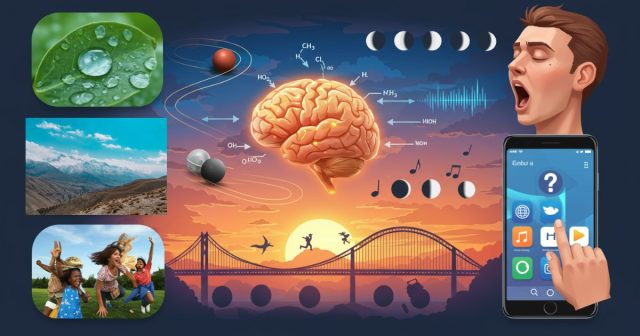Every day, we navigate a world filled with phenomena that inspire curiosity and spark wonder. From the gentle ripple of water in a glass to the vibrant hues of a sunset, countless mysteries await exploration. General knowledge empowers us to decode these everyday wonders, enriching our understanding of nature, science, and human ingenuity. By diving into the science, history, and reasoning behind common occurrences, we gain fresh perspectives on life’s simplest moments. In this post, we’ll uncover twelve fascinating insights that illuminate the hidden mechanisms shaping our daily experiences. Whether you’re sipping morning coffee or gazing at the night sky, these revelations will deepen your appreciation of the world around you. Prepare to embark on a journey that bridges science, technology, biology, and more, all rooted in everyday observations. Let’s begin our exploration of the subtle yet captivating wonders that lie just beyond the surface of our routine.
1. The Secret Life of Water Droplets
Water droplets may appear simple, yet they exhibit complex behaviors governed by surface tension and molecular cohesion. At the microscopic level, water molecules attract each other, forming a skin-like layer that minimizes surface area. This property explains why droplets adopt a nearly perfect spherical shape when suspended or rolling on a smooth surface. Dew that glistens on grass at dawn results from humid air cooling overnight, causing moisture to condense into tiny beads. If you place a drop on a hydrophobic leaf, it will bead up more crisply, demonstrating the repellent effect of certain waxy coatings. Conversely, on hydrophilic surfaces, water spreads out, forming thin films rather than discrete beads. Understanding this interplay of forces has practical applications in inkjet printing, waterproof fabrics, and even microfluidic devices. The next time you admire a dew-laden spiderweb, you’ll recognize the elegant physics behind those sparkling droplets. Engineers use hydrophobic coatings inspired by lotus leaves to create self-cleaning surfaces for windows and solar panels. Biomimicry of water behavior influences innovations from microelectronics cooling to medical diagnostics.

2. Why the Sky is Blue at Noon but Red at Sunset
One of the most striking daily spectacles is the sky’s changing color, driven by light scattering in Earth’s atmosphere. Sunlight contains the full spectrum of colors, each with a unique wavelength and energy level. During midday, the sun sits high overhead, and shorter blue wavelengths scatter more efficiently through nitrogen and oxygen molecules. This phenomenon, known as Rayleigh scattering, directs blue light in all directions, giving the sky its characteristic hue. At sunrise and sunset, sunlight travels through a thicker layer of atmosphere, filtering out shorter wavelengths. The remaining reds and oranges dominate the sky’s palette, casting warm tones across clouds and landscapes. Atmospheric particles like dust and pollution can intensify sunrise and sunset colors, adding dramatic reds and purples. Artists and photographers often time their work to capture these fleeting bursts of natural color. Understanding atmospheric scattering enriches our appreciation of every brilliant dawn and dusk.

3. The Physics of a Rolling Ball on Curves
Watching a ball roll along curved tracks may seem trivial, yet it illustrates core principles of motion and energy. Gravity, inertia, and friction all conspire to dictate the ball’s speed, direction, and eventual rest point. As the ball descends a slope, gravitational potential energy converts into kinetic energy, accelerating its movement. When ascending a curved path, the process reverses, slowing the ball until it reaches a peak and rolls back down. Across curved surfaces, centripetal force keeps the ball adhered to the track, preventing it from flying off. Friction between the ball and track surfaces dissipates energy as heat, gradually reducing its velocity. Energy conservation principles ensure that, absent external forces, a rolling ball will oscillate between defined endpoints. Modeling these dynamics informs designs from precision bearings to amusement park rides. These concepts underpin roller coaster designs, safety mechanisms, and even planetary orbits. Next time you roll a ball down a curved ramp, you’ll witness fundamental physics in action.
4. How Your Memory Recalls Vivid Details
Human memory is not a perfect recording device; it is a dynamic process of encoding, storage, and retrieval. When you perceive an event, sensory inputs convert into neural signals, which your brain organizes and stores. Emotional intensity often enhances memory consolidation, embedding vivid details into long-term storage. During recall, the brain reconstructs past events using cues, which can sometimes alter or distort original memories. Techniques like mnemonic devices, visualization, and spaced repetition improve retention by reinforcing neural connections. Stress, sleep, and nutrition also play critical roles in memory performance, affecting both short-term recall and long-term storage. Research on neuroplasticity shows that regular mental challenges can maintain cognitive vitality into old age. Understanding how memory works benefits students, professionals, and anyone seeking to learn new skills. It also sheds light on eyewitness testimonies, false memories, and the importance of critical thinking. By mastering memory strategies, you can harness the brain’s natural architecture to remember more accurately and efficiently.
5. The Hidden Chemistry of Cooking
Cooking transforms raw ingredients through a web of chemical reactions, creating flavors, textures, and aromas. The Maillard reaction, a chemical interplay between amino acids and sugars, browns meats and enriches savory notes. Caramelization breaks down sugar molecules, producing golden hues and sweet complexity in sauces and desserts. Denaturing proteins in eggs or meat alters their structure, firming textures and improving digestibility. Emulsification binds oil and water, crafting creamy dressings and sauces like mayonnaise and hollandaise. Acid-base interactions, such as marinating in vinegar or citrus, tenderize proteins and infuse flavor. pH changes during cooking transform colors in vegetables, as seen when red cabbage shifts hues in acidic or alkaline environments. Sous-vide techniques leverage precise temperature control to manipulate chemical reactions for optimal texture and flavor. Even heat transfer—whether conduction, convection, or radiation—shapes cooking outcomes by controlling temperature distribution. Appreciating these chemical foundations turns everyday cooking into a mindful, science-inspired craft.
6. The Psychology Behind a Yawn
Yawning is a universal human behavior that remains surprisingly enigmatic to scientists. One theory proposes that yawning cools the brain by drawing in cool air and expelling warm blood. Contagious yawning, where one person’s yawn triggers others, suggests social mirroring and empathy at work. Studies show that people with stronger social bonds or higher empathy are more prone to catch yawns. In animals, yawning may signal stress, social status, or readiness to sleep, hinting at evolutionary roots. Yawning frequency also correlates with neurological conditions, making it a topic of medical interest. Yawning may also serve as a nonverbal communication cue, signaling social cohesion or group vigilance. Ongoing studies investigate neurotransmitters like dopamine and oxytocin to unravel yawning’s deeper neurochemical triggers. Although its full purpose remains unclear, yawning exemplifies how simple actions can reveal deep biological and social mechanisms. Next time you yawn, consider the blend of physiology and psychology behind this seemingly mundane act.
7. The Geography of Time Zones
Time zones are human constructs designed to synchronize local time with the sun’s position overhead. As Earth rotates, different longitudes experience sunrise and sunset at different moments, necessitating standardization. The prime meridian at Greenwich serves as the reference point for Coordinated Universal Time (UTC). Most countries adjust time zones by one-hour increments, but some regions use half- or quarter-hour offsets. Daylight Saving Time introduces seasonal shifts, advancing clocks in spring to extend evening daylight. International guidelines and treaties help standardize timekeeping, though debates over permanent daylight saving still persist. Digital clocks, GPS, and network time protocols automate synchronization, making time zone differences seamless for end users. Navigating time zones is crucial for global travel, commerce, and digital communication across continents. Understanding time geography helps explain jet lag, international broadcasts, and timestamp coordination. Familiarity with time zones transforms how you plan meetings, book flights, and connect with distant friends.
8. The Math in Music: Harmonics Explained
Music resonates with mathematical relationships, particularly through harmonics and frequency ratios. A vibrating string produces a fundamental tone and a series of overtones at integer multiples of its base frequency. These overtones, or harmonics, create rich timbres that distinguish a violin from a piano. Scales and intervals derive from simple ratios, such as the perfect fifth’s 3:2 frequency relationship. Tuning systems like equal temperament balance pure intervals across all keys for versatile composition. Rhythm patterns also involve mathematical subdivisions of beats, from simple quarters to complex polyrhythms. Digital audio workstations use Fourier transforms to visualize sound frequencies, aiding producers in crafting perfect mixes. Acousticians apply harmonic analysis to design auditoriums and speakers for optimal sound distribution. Exploring music through a mathematical lens deepens appreciation for composition, acoustics, and instrument design. Whether you’re listening or creating, the hidden math in music underscores the harmony between art and science.
9. The Biology of Laughter
Laughter engages multiple brain regions, triggering the release of endorphins and reducing stress hormones. Social laughter strengthens group bonds by signaling trust, cooperation, and empathy among participants. Humor perception involves rapid cognitive processing, blending surprise, incongruity, and resolution. Neuroimaging studies reveal that laughter activates the brain’s reward centers, akin to pleasurable stimuli. Even forced or polite laughter can yield physiological benefits, such as improved circulation and relaxation. In primates, laughter-like vocalizations serve as social signals, hinting at evolutionary continuity. Laughter’s contagious nature may involve mirror neurons, which help individuals empathize by mimicking others’ actions. Group laughter can even elevate pain thresholds, showcasing its powerful physiological influence. Laughter therapy and laughter yoga harness these mechanisms for health and wellness applications. Embracing humor in daily life taps into our biology, uplifting mood and fostering social connection.
10. The Engineering of Everyday Bridges
Bridges employ diverse engineering principles to span gaps, support loads, and withstand environmental forces. Beam bridges rely on horizontal beams and simple supports, suitable for short crossings. Arch bridges distribute weight through curved structures, channeling forces into sturdy foundations. Suspension bridges use cables and towers to carry heavy loads across long spans with minimal materials. Truss bridges incorporate triangular units, balancing tension and compression for enhanced stability. Modern materials like pre-stressed concrete and high-strength steel optimize durability and design flexibility. Bridge engineering also considers aesthetic and cultural contexts, creating landmarks that reflect community identity. Inspection technologies like drones and sensors ensure ongoing maintenance and structural health monitoring. Engineers factor in wind, seismic activity, and traffic patterns to ensure safety and longevity. Next time you walk across a bridge, consider the intricate calculations and structures beneath your feet.
11. The Astronomy Behind the Phases of the Moon
The moon’s phases result from its orbit around Earth and the relative positions of the sun, Earth, and moon. New moons occur when the moon sits between Earth and the sun, leaving its lit side hidden from view. As the moon travels along its 29.5-day cycle, we see gradually waxing crescents, quarters, and gibbous phases. Full moons arise when Earth stands between the sun and moon, illuminating the entire near side. Lunar eclipses can only happen during a full moon when Earth’s shadow falls on the moon’s surface. Supermoons, micro moons, and blue moons captivate observers with their timing and orbital nuances. The slight tilt in the moon’s orbit leads to variations in eclipse occurrences and moonrise timings. Amateur astronomers track lunar libration to observe regions of the moon’s surface that periodically come into view. Understanding lunar phases guides night sky watching, tide predictions, and cultural calendars. By tracking these celestial mechanics, you can anticipate and appreciate lunar beauty throughout the month.
12. The Technology in a Smartphone’s Touchscreen
Smartphone touchscreens harness intricate technology to detect touch with precision and responsiveness. Capacitive screens use the conductive properties of the human body to alter an electrostatic field. Resistive screens rely on pressure-sensitive layers that complete circuits when pressed together. Multi-touch detection enables gestures like pinching and swiping by tracking multiple contact points. Advanced algorithms filter noise, predict touch coordinates, and smooth out unintended inputs. Polarization, anti-glare coatings, and oleophobic layers enhance visibility and repel fingerprints. Force-sensitive resistors and ultrasonic proximity sensors complement touchscreen interfaces in specialized devices. As wearable technologies evolve, touch interaction adapts to new form factors like smart rings and AR headsets. Continuous innovation drives foldable displays, haptic feedback, and touchless sensor integration. Peering into a phone’s touchscreen reveals a blend of materials science, engineering, and human-centered design.
Conclusion
From the microscopic dance of water molecules to the grand choreography of celestial bodies, everyday phenomena brim with scientific intrigue. By probing the physics, chemistry, biology, and technology woven into common experiences, we cultivate a richer understanding of our environment. These twelve insights serve not only as fascinating trivia but also as windows into the fundamental principles shaping our world. Embrace curiosity in your daily routines, and let general knowledge guide you toward new discoveries. Armed with these revelations, you’re now equipped to view ordinary moments through an extraordinary lens.
Visit Also: The Science Behind Everyday Phenomena









